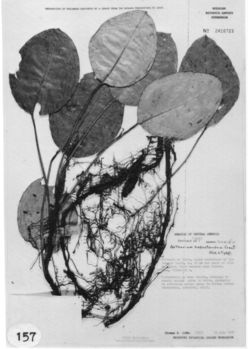




Anthurium subrotundum Croat, sp. nov.
TYPE: Panama. Darien: Serrania de Pirre, along Río Escucho Ruido ca. 16 km N ofAlturas de Nique at ca. 8°48'N, 77°44'W, lower montane rain forest, 1,530-1,550 m, Croat 37951 (MO 2416723, holotype; B, K, PMA, SEL, US, isotypes).
Planta terrestris, repens aul erecta; internodia 1-4 cm long; cataphyllum membranaceum, pereistens plus minusve intactum; petiolus subteres, sulcatus, 14-17 cm longus; glanduloso-punctatus; lamina crasse char-tacea, late elliptica ad plus minusve rotunda, basi rotundata aut late obtusata, 10-11.5 cm longa, utrinque glanduloso-punctata; inflorescentia foliis breviora; pe-dunculus 4-5 cm longus; spatha viridis ad alba, modice membranacea, oblongo-lanceolata, 1.2-1.4 cm longa, 3-4 mm lata; spadix pallide viridis ad albus, 1.5-2 cm longus; baccae ignotae.
Terrestrial in deep debris, creeping to erect; stems to ca. 80 cm long, 4-6 mm diam.; the internodes elongate, 1-4 cm long; leaf scars inconspicuous; roots relatively few, slender; cata-phylls thin, drying pale reddish brown, promptly weathering but remaining more or less intact with fibers exposed, finally deciduous.
LEAVES bicolored, long-petiolate, scattered on upper part of stem only; petioles subterete, sulcate. 14-17 cm long, ca. 3 mm diam., glandular-punctate on surface, much longer than the blades: blades thickly chartaceous (dry), broadly elliptic to almost orbicular, rounded or broadly obtuse ai apex, ending abruptly with a short, do-»-nturned point, rounded to broadly obtuse at the base. ending abruptly on the petiole and briefly decurrent, 10-11.5 cm long, 7.5-8.5 cm v.";:e ''"'-h surfaces semiglossy, the upper surface .conspicuously glandular-punctate (the glands not sunken), drying greenish brown; lower surface conspicuously and densely glandular-punctaie-drying pale brown; midrib prominently raised on both surfaces; primary lateral veins 8-10 per side, departing the midrib at 65-90° angle (though often turning down along the midrib just before joining the midrib) on the same blade, the lowermost more broadly spreading than the upper veins, scarcely raised above, prominulous below: interprimary veins usually much weaker than the primary lateral veins; collective vein arising from near the base, extending to the apex, 3-6 mm from the margin, weakly sunken above, prominulous below, rather prominently loop-connecting the primary lateral veins.
INFLORESCENCE much shorter than the leaves; peduncle 4-5 cm long, ca. 2 mm diam.; spathe green to white, moderately thin, oblong-lanceolate, 1.2-1.4 cm long, 3÷4 mm wide, abruptly acuminate at apex, acute to rounded at base, inserted at ca. 45° angle on peduncle; stipe to 1.5 mm long; spadix short, pale green to white, scarcely tapered, 1.5-2 cm long, ca. 2.5 mm diam., flowers rhombic, 3.6-4 cm long, ca. 3 mm wide, ca. 2 flowers visible in the principal spiral, 3-4 flowers visible in the alternate spiral; tepals semiglossy, lateral tepals 2.5-2.6 mm wide, the inner margin almost straight; pistils not emergent; stamens 0.4 mm wide, retracted beneath the tepals after an-thesis.
INFRUCTESCENCE not known. Fig. 157.
Anthurium subrotundum is endemic to the Serrania de Pirre in western Darien Province in lower montane rain forest at 1,350 to 1,550 m and is known only from the type collection.
The species, a member of section Porphyrochitonium, is distinguished by its terrestrial habit, its elongate slender stems with weathered, reddish brown cataphylls persisting at the upper nodes, its petioles that are much longer than the blades, its broadly ovate to suborbicular leaves that are rounded at the apex with a single collective vein, and especially by its green to white spathe and spadix. It is apparently most closely related to Anthurium collinsii from the Serrania de Canasas that differs in having conspicuously acuminate blades and a reddish spathe and spadix. The species is also related to A. melastomatis from the El Copé (Code) region that differs in having three collective veins on each side of the blade.
The name of the species (subrotundum) refers to the shape of the leaves.

Darien: Serrania de Pirre, N of Alturas de Nique, Croat 37951 (B, K, MO, PMA, SEL, US).